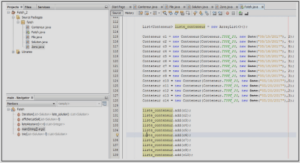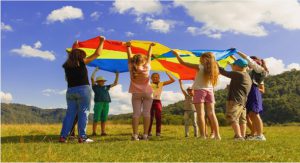Importance of writing
Writing is an important part of our daily lives. It is, however, a difficult skill to learn and master. But why is it so important? Writing is important because it improves communication skills, creative thinking and creativity. Thus, writing is necessary for both school and work because it is the primary basis upon which one’s work, one’s learning, and one’s intellect will be judged—in college, in the workplace, and in the community. Moreover, writing helps the writer express ideas, beliefs, personality, feelings and thoughts to other people in a relatively permanent form. In addition; written pieces could be brought everywhere and writing makes your thinking visible. Also, it helps others give writers a feedback, which helps them refine their ideas. Writing ideas down preserves them so that writers can reflect upon them later, it permits them to evaluate the adequacy of their argument, it stimulates them to extend a line of thought beyond their first impressions. Personal writing builds a connection between the writer and readers in a different way from oral communication, and it helps people to organize their thoughts when seeing them on paper or on a screen.
According to WHITE (1980), there is a traditional view of writing as a poor relative of spoken language. Actually, according to NUNAN (1999) writing used to be treated as a subservient skill whose main function consists in reinforcing the learning and the development of the spoken language. However, writing has been given a new status due to the following reasons: Firstly, in terms of acquisition, writing is to be taught through systematic instructions. Speaking, on the other hand, is acquired naturally without such systematic instructions. In other words, speech is universal (WEIGLE, 2002); that is, everybody can naturally speak a language. Yet, not everybody can necessarily be able to write in the same language like the case of illiterate people. Actually, illiterate people cannot read or write in their mother tongue, but they can speak their language. Secondly, concerning their use as means of communication, writing is more demanding. In fact, writers have no other choices to communicate their thoughts apart from the words they put on the page. As a result, they have to reread, revise, and edit what they have written in order to make sure that the message is clear to the audience. Speakers, on the other hand, have a range of possibilities to help them convey the message such as the use of their voice (pitch, rhythm, stress) and the body (gestures, facial expressions).
With regard to the production time, as WEIGLE (2002) points out; speech is spontaneous and unplanned. It is transitory and must be processed in real time. That is, speakers do not have enough time to plan what they have to say. Writing, on the other hand, must be planned given the fact that the writer does not benefit from immediate or direct feedback from the audience on how well the message is conveyed. For this reason, writing must be planned, revised and edited. As far as the audience is concerned, writers write to a close or distant, known or unknown reader and the answer may be delayed or nonexistent (OLSHTAIN). Namely, writers are removed from the audience and may or may not receive answers from them. Speakers, however, address to a person who is right there, nodding, frowning, or interrupting and giving direct feedback during the conversation. As writers usually write far away from the readers, they are free from direct pressure and can continuously produce written utterances. Speakers, on the other hand, must immediately react under the pressure from their listeners. At the level of content, writing is compact and tends to be more formal. It consists of clauses and more complex sentences.
Speech, as for it, is not quite compact in a way that it is full of repetition characterized by excessive use of ands and buts and other language fillers such as err, umm, well, ok. In other words, speaking is characterized by much redundancy. In sum, writing and speaking, as hinted above, present features which are different from each other from many aspects. Regarding these differences, it cannot be assumed that writing consists simply in putting words down on paper as mere representation of the spoken language. Professional writing and writing for school have a different role compared to personal writing. Formal writing encourages critical thinking in the form of essays, research papers and articles, which help the writer learn how to interpret the world around him in a meaningful manner. Writing about a topic improves the writer’s understanding of the topic, and papers help the writer understand how to successfully construct professional arguments and debates about a topic. Learning how to structure arguments and articulate opinions in writing translates well to the spoken word, helping people to be better at presenting facts and opinions in a calm, rational way.
APPROCHES TO THE TEACHING OF WRITING
The simple following diagram is an attempt to distinguish approach, method, and technique: The diagram clearly shows that approach encompasses the whole orientation of teaching. Approach is the broadest of the three, making technique the most specific, and the method found in between approach and technique. An approach is an enlightened viewpoint toward teaching. It provides the philosophy to the whole process of instruction. As presented by the diagram, the method and technique are just parts and parcels of an approach. An approach gives the overall wisdom; it provides direction, and sets expectations to the entire spectrum of the teaching process. Furthermore, an approach sets the general rule or general principle to make learning possible. A method, on the other hand, is an organized, orderly, systematic, and well-planned procedure aimed at facilitating and enhancing students’ learning. It is undertaken according to some rule, which is usually psychological in nature. That is, it considers primarily the abilities, needs, and interests of the learners. A method is employed to achieve certain specific aims of instruction. To make it as an effective instrument, it should be presented with certain amount of efficiency and ease. More so, the teaching method aims to achieve greater teaching and learning output, thus saving time, efforts and even money on the part of both the teacher and the learner. It directs and guides the teacher and the students in undertaking any class lesson or activity. The procedural variation of a method calls for the third term, technique. A technique encompasses the personal style of the teacher in carrying out specific steps of the teaching process. Through technique, teachers enable to develop, create and implement, using her distinctive way, the procedures (method) of teaching. The difference between an approach, a method and a technique is quite clear. Let us see three complementary approaches, namely, the Structural approach, the Process approach and the Communicative approach.
Teachers’ roles
As far as teachers’ roles are concerned, they mainly consist in involving learners in activities which promote communication such as problem solving activity, information gap activity, and jigsaw activity. Teachers are also viewed as independent participants in learning-teaching group whose main function is to facilitate the communication process between all participants in the classroom and between the participants and the various activities (RICHARDS and RODGERS, 2001). In other words, teachers behave like students taking part in activities and focusing more on learning than on teaching. Finally, teachers are monitors as they monitor students’ learning process; give them opportunities to communicate with each other and allowing them to express themselves without too much intervention. In a word, the communicative approach, like the process approach, is a learner-centered approach which enables learners to be exposed to the target language through the various activities available for this end. This approach is more specific to spoken language than to written language. As a result, if writing is taught exclusively through communicative approach, students’ writing will be handicapped by lack of the various features of written language such as grammar, mechanics, etc which are other skills that they need to master in order to achieve successful communication through writing. On the whole, these three approaches to the teaching of writing, as we have demonstrated, have their own features which complement each other. In other words, although the proponents of these three approaches try to portray them as incompatible, they are, in fact, complementary. The following table will enable us to see in summary the features, the learners’ roles and the teachers’ roles of the three approaches with which we dealt above; namely structural, process and communicative approaches.
Free writing As its name indicates, free writing gives us a hint that learners are not controlled or guided anymore. They are assigned to write on a given topic taking into account the audience and the purpose for their writing. Hence, this writing activity is mainly assigned to advanced learners. In other words, learners are in charge of the content of their own writing and shape it according to the audience and purpose. As a result, free writing requires planning, drafting, revising and editing in order to fit the audience concerning the choice and use of language and register. Its main goal consists in giving students the opportunities to express themselves freely through writing. There are some activities, which are helpful for students to start writing assignment. According to KROLL as cited by CELCE-MARCIA (2001) they are as the followings: Writing based on a text: We can teach students how to write by giving a short text as a model, for example students read a short text, and study particular features of it.
They then write a paragraph that is similar, but involves some changes. For example, students read a paragraph about a student’s day, then they write about their own day; students read a description of a room, and then write a description of another room shown in a picture. Brainstorming: This is often a group exercise in which all of the students in the class are encouraged to participate by sharing their collective knowledge about a particular subject. One way to structure this is for the teacher to suggest a broad topic, such as reasons for choosing a particular academic major, and have students call out as many associations as possible, which the teacher can write on the board. The result would be far more material generated than any one student is likely to think of on his/her own, and then all students can utilize any or all of the information when turning to the preparation of their first drafts.
Listing: Unlike brainstorming, as described above, listing can be a quite and essentially individual activity. Again, as a first step in finding an approach to a particular subject area, the students are encouraged to produce as lengthy a list as possible of all the subcategories that come to mind as they think about the topic at hand. This is an especially useful activity for students, who might be constrained by undue concern for expressing their thoughts in grammatically correct sentences, because lists do not require complete sentences. Free writing: Freed from the necessity of worrying about grammar and format, students can often generate a great deal of prose which provide useful raw material to use in addressing the writing assignment at hand. This technique often works best if the teacher provides an opening clause or sentence for the students to start with. For example, if the students are supposed to write a paper about one’s personal philosophy of life, they can begin with the words like “life is difficult but it is also worthwhile”. The students copy this sentence and continue to write down whatever comes into their heads.
0. INTRODUCTION |



